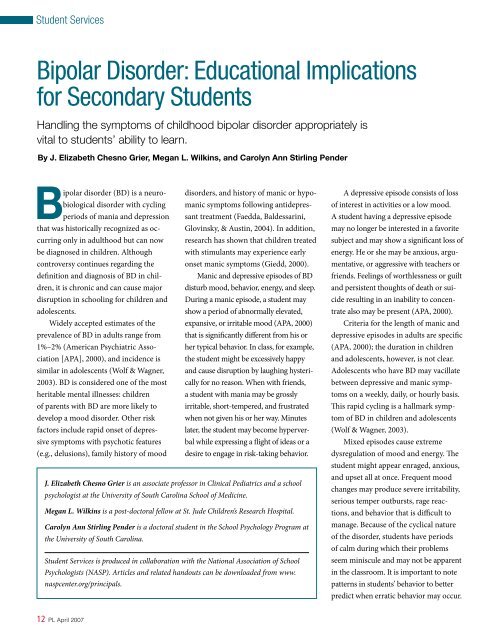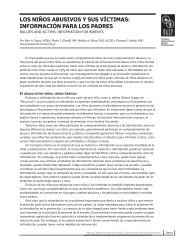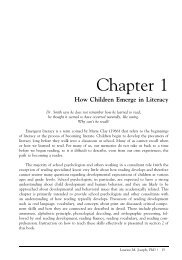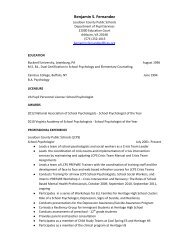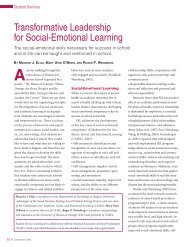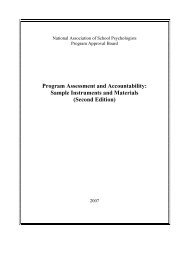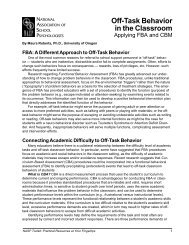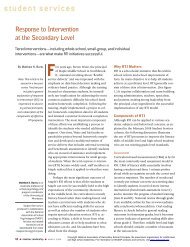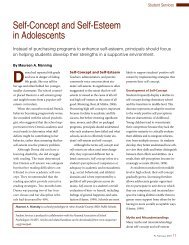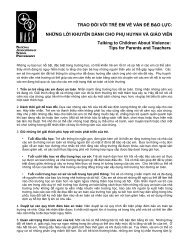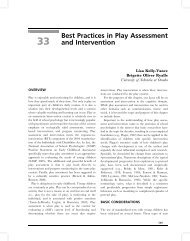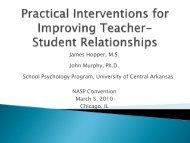Bipolar Disorder: Educational Implications for Secondary Students
Bipolar Disorder: Educational Implications for Secondary Students
Bipolar Disorder: Educational Implications for Secondary Students
Create successful ePaper yourself
Turn your PDF publications into a flip-book with our unique Google optimized e-Paper software.
Student Services<br />
<strong>Bipolar</strong> <strong>Disorder</strong>: <strong>Educational</strong> <strong>Implications</strong><br />
<strong>for</strong> <strong>Secondary</strong> <strong>Students</strong><br />
Handling the symptoms of childhood bipolar disorder appropriately is<br />
vital to students’ ability to learn.<br />
By J. Elizabeth Chesno Grier, Megan L. Wilkins, and Carolyn Ann Stirling Pender<br />
<strong>Bipolar</strong> disorder (BD) is a neurobiological<br />
disorder with cycling<br />
periods of mania and depression<br />
that was historically recognized as occurring<br />
only in adulthood but can now<br />
be diagnosed in children. Although<br />
controversy continues regarding the<br />
definition and diagnosis of BD in children,<br />
it is chronic and can cause major<br />
disruption in schooling <strong>for</strong> children and<br />
adolescents.<br />
Widely accepted estimates of the<br />
prevalence of BD in adults range from<br />
1%–2% (American Psychiatric Association<br />
[APA], 2000), and incidence is<br />
similar in adolescents (Wolf & Wagner,<br />
2003). BD is considered one of the most<br />
heritable mental illnesses: children<br />
of parents with BD are more likely to<br />
develop a mood disorder. Other risk<br />
factors include rapid onset of depressive<br />
symptoms with psychotic features<br />
(e.g., delusions), family history of mood<br />
J. Elizabeth Chesno Grier is an associate professor in Clinical Pediatrics and a school<br />
psychologist at the University of South Carolina School of Medicine.<br />
Megan L. Wilkins is a post-doctoral fellow at St. Jude Children’s Research Hospital.<br />
Carolyn Ann Stirling Pender is a doctoral student in the School Psychology Program at<br />
the University of South Carolina.<br />
Student Services is produced in collaboration with the National Association of School<br />
Psychologists (NASP). Articles and related handouts can be downloaded from www.<br />
naspcenter.org/principals.<br />
12 PL April 2007<br />
disorders, and history of manic or hypomanic<br />
symptoms following antidepressant<br />
treatment (Faedda, Baldessarini,<br />
Glovinsky, & Austin, 2004). In addition,<br />
research has shown that children treated<br />
with stimulants may experience early<br />
onset manic symptoms (Giedd, 2000).<br />
Manic and depressive episodes of BD<br />
disturb mood, behavior, energy, and sleep.<br />
During a manic episode, a student may<br />
show a period of abnormally elevated,<br />
expansive, or irritable mood (APA, 2000)<br />
that is significantly different from his or<br />
her typical behavior. In class, <strong>for</strong> example,<br />
the student might be excessively happy<br />
and cause disruption by laughing hysterically<br />
<strong>for</strong> no reason. When with friends,<br />
a student with mania may be grossly<br />
irritable, short-tempered, and frustrated<br />
when not given his or her way. Minutes<br />
later, the student may become hyperverbal<br />
while expressing a flight of ideas or a<br />
desire to engage in risk-taking behavior.<br />
A depressive episode consists of loss<br />
of interest in activities or a low mood.<br />
A student having a depressive episode<br />
may no longer be interested in a favorite<br />
subject and may show a significant loss of<br />
energy. He or she may be anxious, argumentative,<br />
or aggressive with teachers or<br />
friends. Feelings of worthlessness or guilt<br />
and persistent thoughts of death or suicide<br />
resulting in an inability to concentrate<br />
also may be present (APA, 2000).<br />
Criteria <strong>for</strong> the length of manic and<br />
depressive episodes in adults are specific<br />
(APA, 2000); the duration in children<br />
and adolescents, however, is not clear.<br />
Adolescents who have BD may vacillate<br />
between depressive and manic symptoms<br />
on a weekly, daily, or hourly basis.<br />
This rapid cycling is a hallmark symptom<br />
of BD in children and adolescents<br />
(Wolf & Wagner, 2003).<br />
Mixed episodes cause extreme<br />
dysregulation of mood and energy. The<br />
student might appear enraged, anxious,<br />
and upset all at once. Frequent mood<br />
changes may produce severe irritability,<br />
serious temper outbursts, rage reactions,<br />
and behavior that is difficult to<br />
manage. Because of the cyclical nature<br />
of the disorder, students have periods<br />
of calm during which their problems<br />
seem miniscule and may not be apparent<br />
in the classroom. It is important to note<br />
patterns in students’ behavior to better<br />
predict when erratic behavior may occur.
Coexisting <strong>Disorder</strong>s<br />
BD commonly overlaps with other<br />
psychiatric disorders. Biederman, Mick,<br />
and Faraone (2004) found that 87% of<br />
children with BD also had attention<br />
deficit/hyperactivity disorder (ADHD),<br />
although only 20% of children with<br />
ADHD met criteria <strong>for</strong> BD. Symptoms<br />
of grandiosity, elevated mood, flight<br />
of ideas, and decreased need <strong>for</strong> sleep<br />
distinguish BD from ADHD (Pavuluri,<br />
Birmaher, & Naylor, 2005). The combination<br />
of ADHD with BD often results<br />
in severe impairment with increased<br />
psychotic symptoms, need <strong>for</strong> hospitalization,<br />
and school failure (Wolf &<br />
Wagner, 2003) in addition to increased<br />
impulsivity that may lead youth to act in<br />
lethal ways, such as suicide (Biederman<br />
et al.). Children and adolescents with<br />
BD often meet criteria <strong>for</strong> oppositional<br />
defiant, conduct, anxiety, and learning<br />
disorders. Accurate diagnosis of BD is<br />
complicated by the complexity of symptoms<br />
and frequent co-occurrence with<br />
other disorders.<br />
Treatment and Intervention<br />
Because of the novel recognition of pediatric<br />
BD, treatment in children has been<br />
an extension of adult treatment. Only recently<br />
has intervention literature focused<br />
on treatment options that are specifically<br />
<strong>for</strong> children and adolescents with BD. To<br />
stabilize the severe behaviors often seen<br />
in pediatric BD, psychotropic medications<br />
are commonly used as first-line<br />
treatment. Without mood stabilization<br />
through medication, students may not<br />
adequately benefit from other interventions<br />
(McIntosh & Trotter, 2006).<br />
Current psychosocial treatment<br />
guidelines <strong>for</strong> childhood BD are largely<br />
based on clinical experience, with scant<br />
empirical research establishing their<br />
effectiveness. Cognitive-behavioral<br />
therapy strategies and family psychoeducation<br />
approaches are highlighted as<br />
the most effective treatments (Kowatch<br />
et al., 2005; McIntosh & Trotter, 2006).<br />
Interventions are delivered at the<br />
individual or family level and include<br />
cognitive restructuring <strong>for</strong> depressive<br />
symptoms, problem-solving strategies to<br />
intervene with emotional dysregulation,<br />
and behavior management techniques<br />
to establish routine and consistency<br />
(e.g., Pavuluri et al., 2004). Family psychoeducation—providing<br />
in<strong>for</strong>mation<br />
and guidance to families in a teaching<br />
<strong>for</strong>mat—has also proven to decrease<br />
symptom expression and increase<br />
parental knowledge and positive family<br />
interactions (Fristad, Goldberg-Arnold<br />
& Gavazzi, 2003; Pavuluri et al., 2004).<br />
Schools’ Response<br />
Each student with BD has a unique<br />
symptom pattern, which makes the<br />
development and use of intervention<br />
plans in the school setting challenging.<br />
A collaborative approach that uses<br />
Case Study<br />
problem-solving strategies and includes<br />
families, school staff members, and<br />
medical and mental health providers is<br />
necessary to provide appropriate school<br />
intervention <strong>for</strong> students with BD.<br />
School-based interventions <strong>for</strong> these<br />
students can include different levels<br />
of special education services, specific<br />
classroom modifications, and direct<br />
services provided by school counselors<br />
and psychologists. <strong>Students</strong> diagnosed<br />
with BD can be served in general education<br />
or special education classrooms or<br />
a combination of both.<br />
<strong>Students</strong> who have less-severe symptoms<br />
but who show limited academic<br />
progress because of BD may benefit<br />
from a Section 504 plan, which might<br />
include specific classroom accommodations<br />
and school-based counseling.<br />
An IEP is often created under the<br />
“Emotional Disability” or “Other Health<br />
Impaired” (OHI) category of disability,<br />
but <strong>for</strong> students to qualify <strong>for</strong> these<br />
services, their symptoms must adversely<br />
affect learning.<br />
Rylan is an eighth-grade student with early onset bipolar disorder (BD), attention deficit/hyperac-<br />
tivity disorder (ADHD), oppositional tendencies, social problems, and writing difficulties. Rylan’s<br />
behavior results in classroom disruptions, peer conflicts, teacher frustration, and poor academic<br />
per<strong>for</strong>mance. Rylan’s educators are struggling with how to best support his needs.<br />
The assistant principal who deals with Rylan’s misbehavior has noticed escalating concerns<br />
since earlier this school year. Rylan has only recently been sent to the office because of his short<br />
temper, refusal to write in most classes, argumentative interactions with teachers, and fights<br />
with peers. Upon reviewing Rylan’s record and discovering his diagnoses, the assistant principal<br />
immediately puts a plan together to support Rylan.<br />
The assistant principal created a plan of action <strong>for</strong> Rylan when problems first began. A<br />
proactive meeting was held with his parents and teachers. Medical providers were contacted<br />
immediately <strong>for</strong> consultation. School counseling ef<strong>for</strong>ts began while medication changes were<br />
being completed. Learning issues were assessed and teachers were given support to deal with<br />
Rylan in the classroom via the development and implementation of a 504 plan. These collabora-<br />
tive prevention measures allowed the assistant principal to manage the situation and support<br />
Rylan and his teachers.<br />
PL April 2007 13
Student Services<br />
Symptoms and Expression of Depressive and Manic Episodes in Children and Adolescents<br />
Depressive Episode<br />
1. Depressed Mood and/or<br />
2. Loss of Interest and<br />
Four Other Symptoms Possible Expression in Children and Adolescents<br />
3. Weight loss/gain Uninterested in eating and/or overeats.<br />
4. Insomnia or hypersomnia Difficulty falling and staying asleep. Sleeps more than usual.<br />
5. Psychomotor agitation or retardation Hyperactive, difficulty sitting still, and/or impulsive. Less active and interactive.<br />
6. Fatigue or loss of energy Needs more rest, complains when pushed to do activities, and/or pretends to<br />
be sick.<br />
7. Feelings of worthlessness or inappropriate guilt Makes negative self-comments, such as “I am stupid” and “No one likes me.”<br />
8. Diminished ability to think or concentrate Has poor concentration, is disorganized, and/or distractible.<br />
9. Recurrent thoughts of death, suicidal ideation/attempt. Talks about dying or has themes of death in conversation, play, or artwork.<br />
Manic Episode<br />
1. Elevated and/or expansive mood and/or<br />
2. Irritable mood and<br />
Three (four if mood is only irritable) Other Symptoms: Possible Expression in Children and Adolescents<br />
3. Inflated self-esteem or grandiosity Demands to be center of attention or overcommits to projects/activities. Has<br />
hallucinations (e.g., hears/sees things) or tells eccentric stories.<br />
4. Decreased need <strong>for</strong> sleep Full of energy and requires little sleep (e.g., wanders around house nightly<br />
looking <strong>for</strong> things to do). Gets very little sleep but is full of energy next day<br />
with no tiredness.<br />
5. More talkative than usual Talks rapidly, loudly, and incessantly without allowing others to enter conversation.<br />
6. Flight of ideas/racing thoughts In absence of language problems, does not make sense when they talk.<br />
Comments they can’t get things done because their thoughts are interrupting<br />
them.<br />
7. Distractibility More than typical, has difficulty paying attention and/or is disorganized.<br />
8. Psychomotor agitation/increase in goal directed activity Overly active, spends more time playing and completing a specific activity<br />
than usual, and/or displays impulsive behaviors.<br />
9. Excessive involvement in pleasurable activities that have high potential <strong>for</strong><br />
painful consequences (i.e., poor judgment).<br />
14 PL April 2007<br />
Shows hypersexual behaviors (in the absence of sexual abuse) or makes<br />
inappropriate displays of affection. Engages in risk-taking behaviors and takes<br />
dares easily from others.<br />
Sources:<br />
American Psychiatric Association. (2000). Diagnostic and statistical manual of mental disorders-text revision (4th ed.). Washington, DC: Author.<br />
Geller, B., Craney, J. L., Bolhofner, K., DelBello, M. P., Axelson, D., Luby, J., et al. (2003). Phenomenology and longitudinal course of children with a prepubertal and early adolescent<br />
bipolar disorder phenotype. In B. Geller & M.P. DelBello (Eds.), <strong>Bipolar</strong> <strong>Disorder</strong> in Childhood and Early Adolescence (pp. 25–50). New York: Guil<strong>for</strong>d.<br />
Kowatch, R. A., Fristad, M., Birmaher, B., Wagner, K. D., Findling, R. L., & Hellander, M. (2005). Treatment guidelines <strong>for</strong> children and adolescents with bipolar disorder: Child psychiatric<br />
workgroup on bipolar disorder. Journal of American Academy of Children and Adolescent Psychiatry, 4(3), 213–235.<br />
McIntosh, D., & Trotter, J. (2006). Early onset bipolar spectrum disorder: Psychopharmacological, psychological, and educational management. Psychology in the Schools, 43(4),<br />
451–460.
Certain symptoms of BD lend<br />
themselves to specific interventions.<br />
Papolos, Hatton, Norelli, Garcia, and<br />
Smith (2002) suggest such strategies<br />
as adjusting the student’s academic<br />
schedule to accomodate a disturbed<br />
sleep-wake cycle, allowing a “safe zone”<br />
<strong>for</strong> students who experience significant<br />
irritability or rage episodes, and allowing<br />
verbal or typed responses on schoolwork<br />
<strong>for</strong> students who exhibit perfectionistic<br />
tendencies. <strong>Students</strong> who have attention<br />
problems may benefit from preferential<br />
seating, frequent breaks, and organizational<br />
aids.<br />
School staff members should become<br />
familiar with the potential side<br />
effects of the psychotropic medications<br />
that are used to treat BD. Any change<br />
in school per<strong>for</strong>mance, energy level,<br />
behavior, social interactions, or mood<br />
should be shared with parents and<br />
medical staff members immediately.<br />
A key role <strong>for</strong> school administrators<br />
is consulting with other members of the<br />
student’s treatment team on an ongoing<br />
basis. This treatment team typically<br />
consists of a mental health provider, a<br />
physician, a school nurse, at least one<br />
teacher, and at least one parent. Consultation<br />
may involve discussing situations<br />
that are difficult <strong>for</strong> the student and<br />
problem behaviors, developing intervention<br />
and crisis plans, and offering<br />
suggestions as a contributing member in<br />
a multidisciplinary team meeting.<br />
Consultation with family members<br />
of students with BD involves supporting<br />
the family and providing in<strong>for</strong>mation<br />
regarding school services <strong>for</strong> the<br />
student. School leaders also can <strong>for</strong>ge<br />
positive relationships with community<br />
mental health and medical professionals<br />
by supporting regular contact with these<br />
providers or allotting time and resources<br />
<strong>for</strong> staff members to do so.<br />
Resources<br />
Web sites<br />
Child and Adolescent <strong>Bipolar</strong> Foundation: www.bpkids.org<br />
Depression and <strong>Bipolar</strong> Support Alliance: www.dbsalliance.org<br />
Juvenile <strong>Bipolar</strong> Research Foundation: www.bpchildresearch.org<br />
Books <strong>for</strong> Educators<br />
Understanding and Educating Children and Adolescents With <strong>Bipolar</strong> <strong>Disorder</strong>: A Guide <strong>for</strong> Educators. 2003.<br />
M. Andersen, J. Boyd-Kubisak, R. Field, & S. Vogelstein. Northfield, IL: The Josselyn Center.<br />
The Life of a <strong>Bipolar</strong> Child: What Every Parent and Professional Needs to Know. 2000. T. Carlson. Duluth, MN:<br />
Benline Press.<br />
Books <strong>for</strong> Parents<br />
Raising a Moody Child: How to Cope With Depression and <strong>Bipolar</strong> <strong>Disorder</strong>. 2004. M. A. Fristad & J. S.<br />
Goldberg-Arnold. New York: Guil<strong>for</strong>d Press.<br />
The <strong>Bipolar</strong> Child: The Definitive and Reassuring Guide to Childhood’s Most Misunderstood <strong>Disorder</strong> (3rd ed.).<br />
2006. D. Papolos & J. Papolos. New York: Broadway Books.<br />
Conclusion<br />
Early-onset BD severely impairs all<br />
areas of the student’s life. Administrators<br />
have a unique opportunity to provide<br />
guidance to various staff members who<br />
work directly with students with BD to<br />
support their schooling. To provide this<br />
support, administrators should continue<br />
to seek in<strong>for</strong>mation about BD, help and<br />
support teachers and other school staff<br />
members in identifying and devising<br />
appropriate intervention techniques <strong>for</strong><br />
problem behaviors, consult with parents<br />
to support their needs in dealing with<br />
educational issues of students with BD,<br />
work with school staff members and<br />
community providers to de-stigmatize<br />
mental health problems and treatment,<br />
and <strong>for</strong>ge positive relationships and<br />
model productive interactions with the<br />
student’s entire treatment team. PL<br />
References<br />
n American Psychiatric Association.<br />
(2000). Diagnostic and statistical manual<br />
of mental disorders-text revision (4th ed.).<br />
Washington, DC: Author.<br />
n Biederman, J., Mick, E., & Faraone, S.<br />
V. (2004). A prospective follow-up study<br />
of pediatric bipolar disorder in boys with<br />
attention-deficit/hyperactivity disorder.<br />
Journal of Affective <strong>Disorder</strong>s, 82S,<br />
S17–S23.<br />
n Faedda, G. L., Baldessarini, R. J.,<br />
Glovinsky, I., & Austin, N. B. (2004). Pediatric<br />
bipolar disorder: Phenomenology<br />
and course of illness. <strong>Bipolar</strong> <strong>Disorder</strong>s, 6,<br />
305–313.<br />
n Fristad, M. A., Goldberg-Arnold, J. S.,<br />
& Gavazzi, S. M. (2003). Multi-family psychoeducation<br />
groups in the treatment of<br />
children with mood disorders. Journal of<br />
Marital and Family Therapy, 29, 491–504.<br />
n Giedd, J. N. (2000). <strong>Bipolar</strong> disorder<br />
and attention-deficit/hyperactivity disorder<br />
in children and adolescents. Journal of<br />
Clinical Psychiatry, 61, 31–34.<br />
n Kowatch, R. A., Fristad, M., Birmaher,<br />
B., Wagner, K. D., Findling, R. L., & Hellander,<br />
M. (2005). Treatment guidelines<br />
<strong>for</strong> children and adolescents with bipolar<br />
disorder: Child psychiatric workgroup<br />
on bipolar disorder. Journal of American<br />
Academy of Children and Adolescent Psychiatry,<br />
4(3), 213–235.<br />
n McIntosh, D., & Trotter, J. (2006). Early<br />
onset bipolar spectrum disorder: Psychopharmacological,<br />
psychological, and<br />
educational management. Psychology in<br />
the Schools, 43(4), 451–460.<br />
n Papolos, J., Hatton, M. J., Norelli, S.,<br />
Garcia, C. E., & Smith, A. M. (2002). Challenging<br />
negative remarks that threaten to<br />
derail the IEP process. Retrieved February<br />
19, 2005, from www.bpchildresearch.org/<br />
edu_<strong>for</strong>ums/accommodations.html<br />
n Pavuluri, M. N., Birmaher, B., & Naylor,<br />
M. W. (2005). Pediatric bipolar disorder: A<br />
review of the past 10 years. Journal of the<br />
American Academy of Child and Adolescent<br />
Psychiatry, 44(9), 846–871.<br />
n Pavuluri, M. N., Grayczyk, P., Carbray,<br />
J., Heidenreich, J., Henry, D., & Miklowitz,<br />
D. (2004). Child and family focused cognitive<br />
behavior therapy in pediatric bipolar<br />
disorder. Journal of the American Academy<br />
of Child and Adolescent Psychiatry, 43,<br />
528–537.<br />
n Wolf, D. V., & Wagner, K. D. (2003). <strong>Bipolar</strong><br />
disorder in children and adolescents.<br />
CNS Spectrums, 8, 954–959.<br />
PL April 2007 15


